How to turn an old router into a wireless bridge
Looking to connect Ethernet devices without wiring your home? You can turn an old router into a wireless bridge and solve your problem.
What is wireless bridge?

Wireless bridge is a type of connection in which you wirelessly connect two or more local area networks (LANs). By combining two networks together via a wireless bridge, you essentially create one larger network where all devices are connected and have access to the Internet.
The benefit of using this type of connection is that it saves you money and time by using WiFi instead of buying and installing long Ethernet cables.
Turn an old router into a wireless bridge using OpenWrt
Wireless bridge devices can be quite expensive. But if you only need to connect to the network in one building, setting up an old router as a wireless bridge is enough and only requires a few steps:
- Flash OpenWrt (open source router firmware with additional functions) on the old router.
- Set up a WiFi interface connected to the main router and a LAN interface connected to Ethernet devices.
- Connect WiFi and LAN interfaces together, connect Ethernet devices to the main router, access the Internet and all other devices on its network.
To turn an old router into a wireless bridge, you will need the following hardware:
- A broadband Internet connection
- Two Ethernet cables
- Two WiFi routers (One connected to the Internet and the other as your wireless bridge device)
- A computer with an Ethernet port
Set up the initial wireless bridge
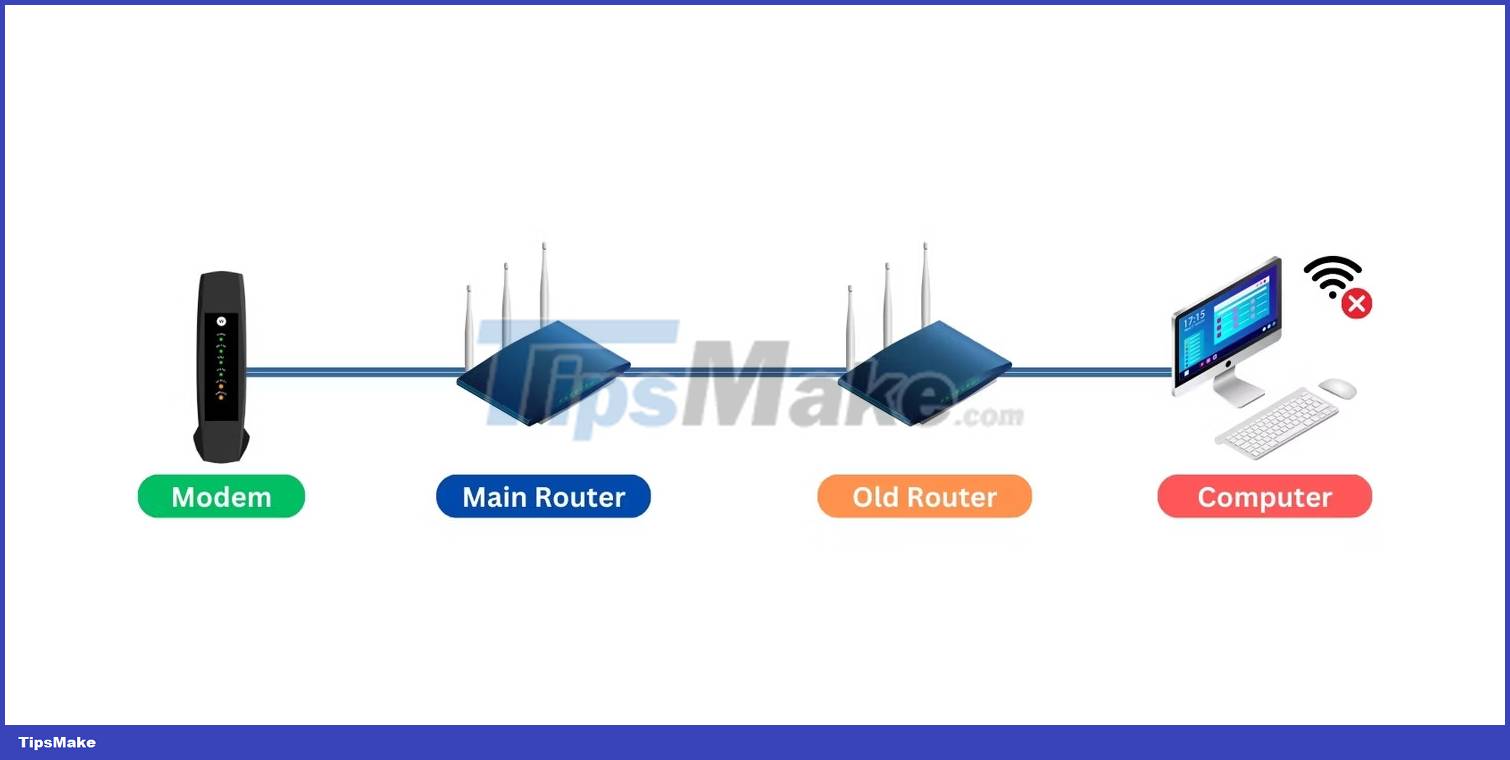
Make sure your Internet connection is working.
- Select the appropriate Ethernet cable and connect your main router (the router connected to the Internet) to the old router. This will give the old router access to the Internet to download firmware.
- Connect your computer to the old router via Ethernet.
- Turn off your computer's WiFi to ensure it is only connected to the old router.
- Open your browser and connect to the old router's web configuration page. If you're not sure, check the default gateway address. To find the default gateway:
- On Windows, and enter ipconfig
- On macOS or Linux, and enter ifconfig
The default gateway will be labeled as such on each operating system.
Download OpenWrt firmware
1. Visit openwrt.org
2. If you know the exact unit and version of your router, scroll down the website and find Download a firmware image for your device (firmware selector). Now, search for your device using the search bar. However, if you're not sure which version you're using, go to Download a firmware image for your device (Table of Hardware) and scroll through the list until you find your specific device.
If your router has multiple versions, open each link in the Device Page column and verify that the Hardware Highlight and image match the hardware equipped on your router.
3. Download both the kernel file and upgrade the BIN.
Please note that routers often come in different versions that use slightly different hardware. Make sure to download the appropriate firmware of your router and its specific version.
Install OpenWrt on the router
OpenWrt supports thousands of devices from different manufacturers. Due to hardware and firmware differences, you must follow OpenWrt's instructions to install OpenWrt firmware on your specific device.
In general, supported devices from popular manufacturers such as Linksys, D-Link, TP-Link and NetGear will have easier firmware installation. Other devices like Xiaomi and BT may require additional tools like OpenWrtInvastion or even access the bootloader using different serial communication protocols like UART and JTAG.
If your router is supported by OpenWrt, instructions will be provided on its website. Be sure to only follow the instructions that correspond to your specific device and router version, and don't forget to upgrade your kernel when available.
Warning: Modifying your device's bootloader can brick your router or put it in a boot loop. Read the instructions carefully and re-evaluate your steps or ask the OpenWrt community when something goes wrong with the instructions. If you brick your device, you can usually find unblocking instructions in the installation and upgrade section of the guide.
After you have installed OpenWrt on your old router, it's time to configure your device as a wireless bridge.
Configure the wireless bridge
Step 1: Download Luci-Proto-Relay
Luci-proto-relay is installable software for OpenWrt devices. It allows the router to use the forwarding bridge protocol, which is essential for connecting LAN and WiFi interfaces.
1. Before downloading the software, update the system data settings to ensure you do not encounter any SSL errors. On the top toolbar, go to System > System, then click Sync with browser > Save & Apply.
2. Now, go to System > Software and click Update list. After updating, search for luci-proto-relay and press Install.
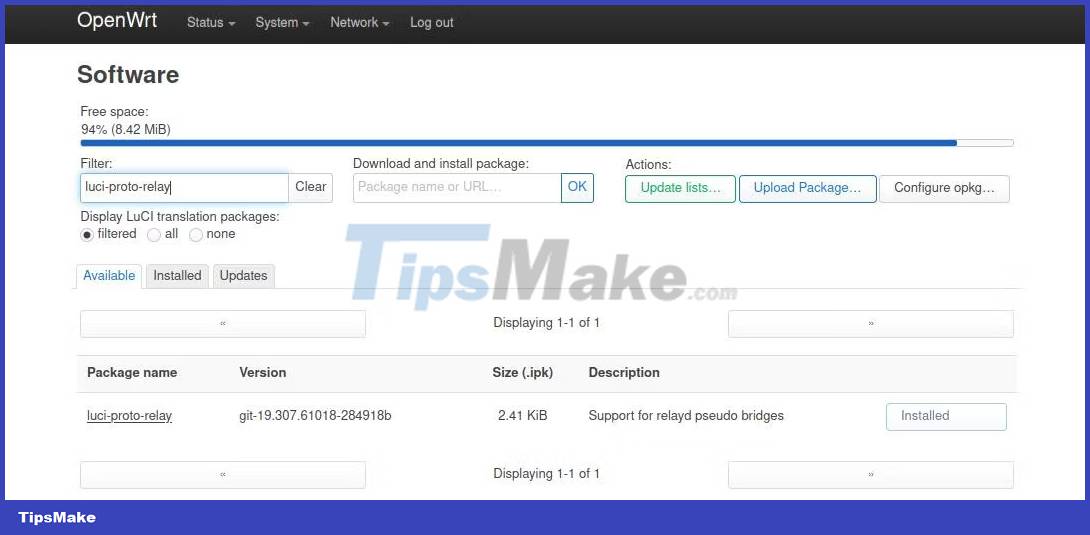
3. Next, reboot the router by going to System > Reboot and clicking Reboot system.
This ensures that the software is installed properly and is available when needed later.
Step 2: Configure the LAN interface
Since we want the main router to provide all the device's IP addresses, it's time to configure the old router to disable DCHP.
1. To turn off DCHP on the old router, go to Network > Interface. Select the LAN interface and click Edit.
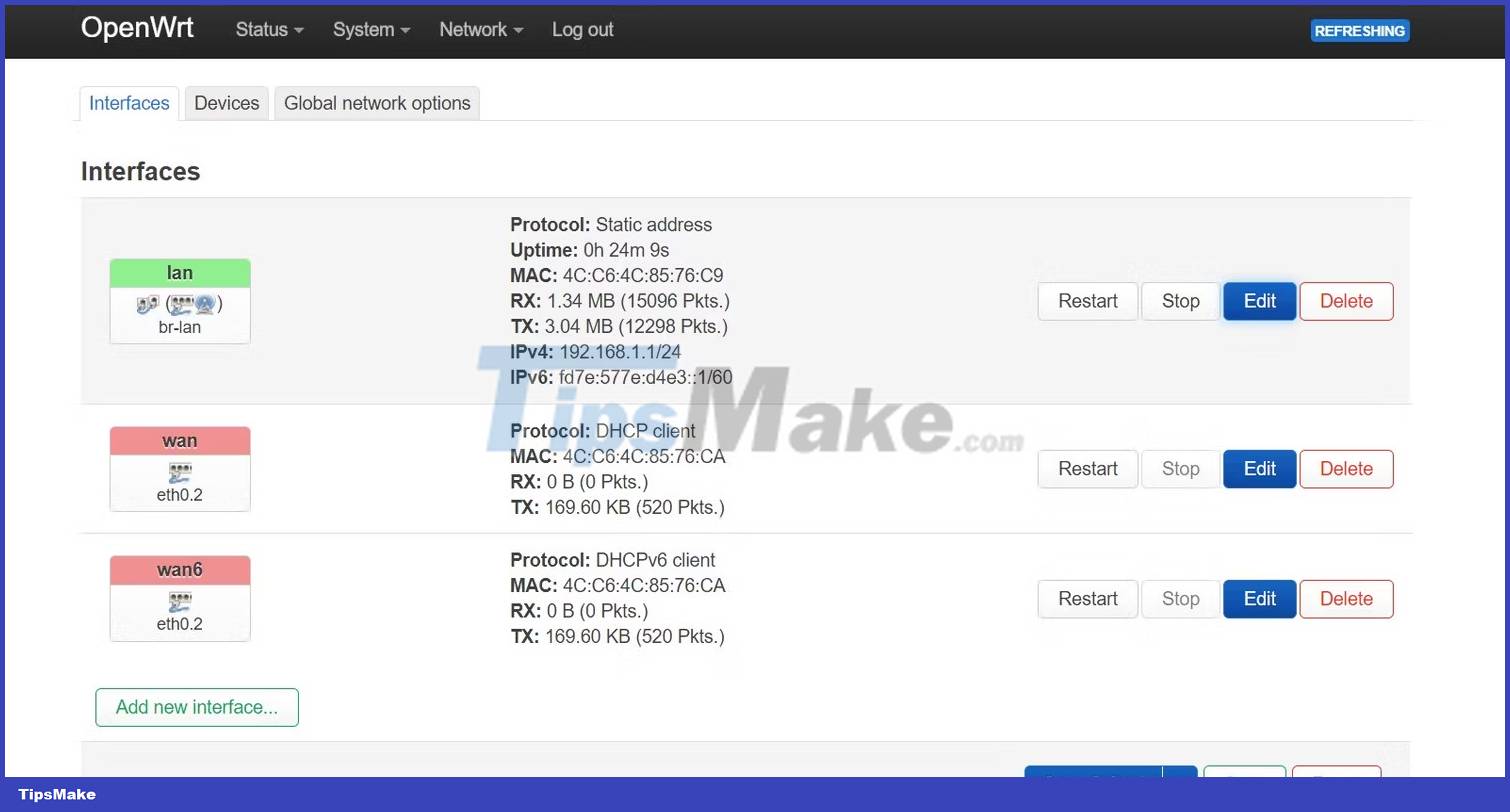
2. In General Settings, make sure to set Protocol to Static address.
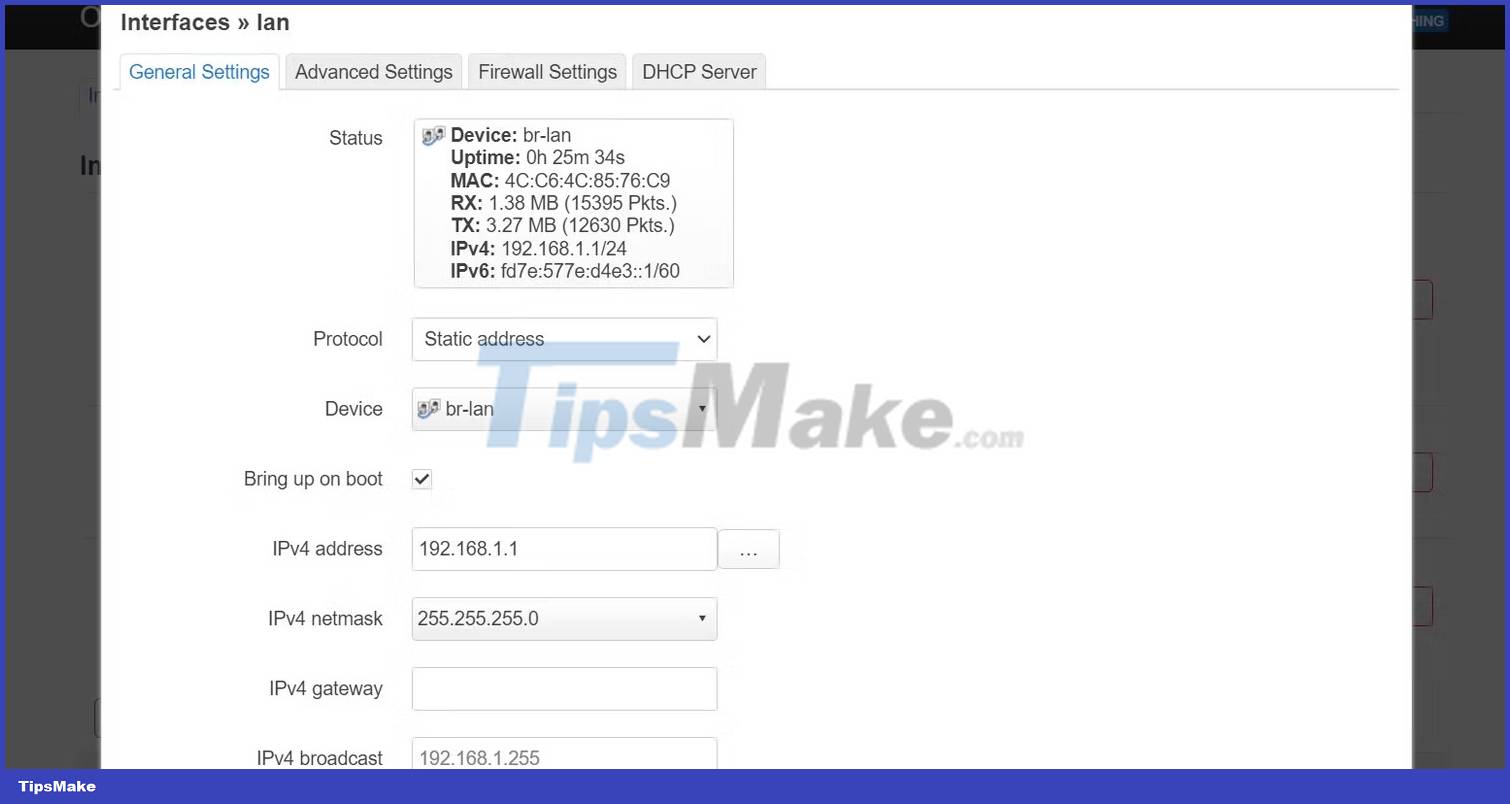
3. Go to DCHP Server, check the Ignore interface box and click Save.
Step 3: Configure the WiFi interface
Now configure the WiFi interface to receive data from the main router.
1. Go to Network > Wireless and click Scan on radio, then click Join Network on the main router's WiFi access point.
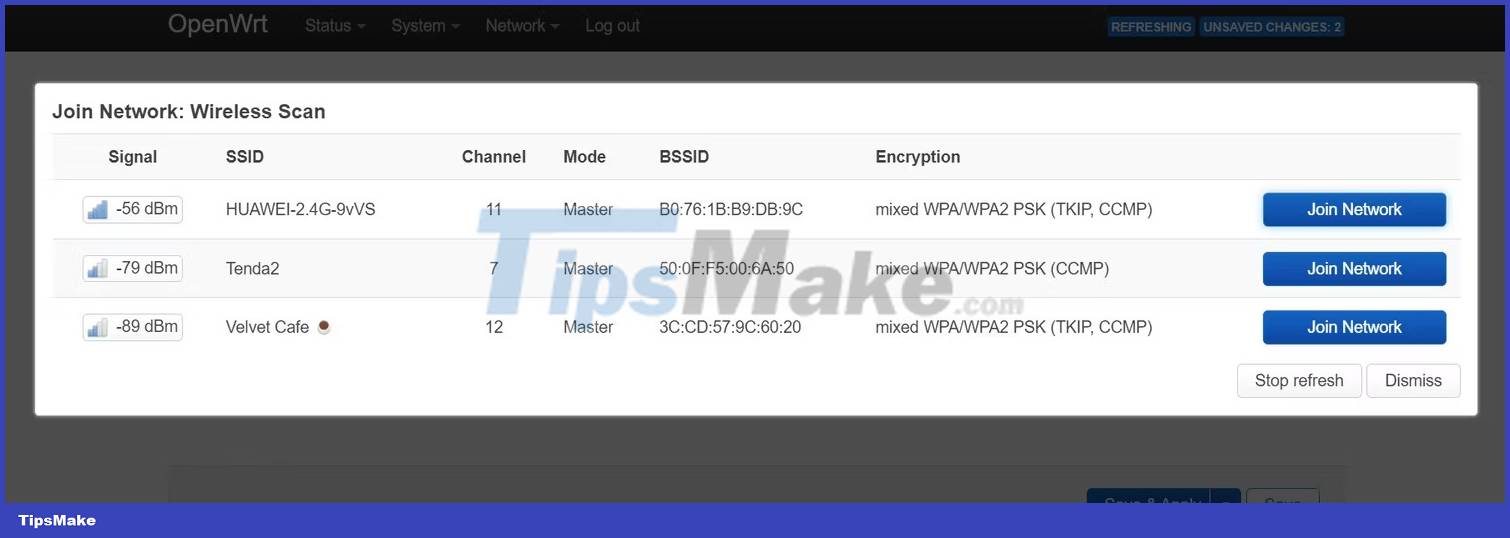
2. On the pop-up menu, enter the main router's WiFi password in the WPA passphrase and set Assign firewall-zone to lan.
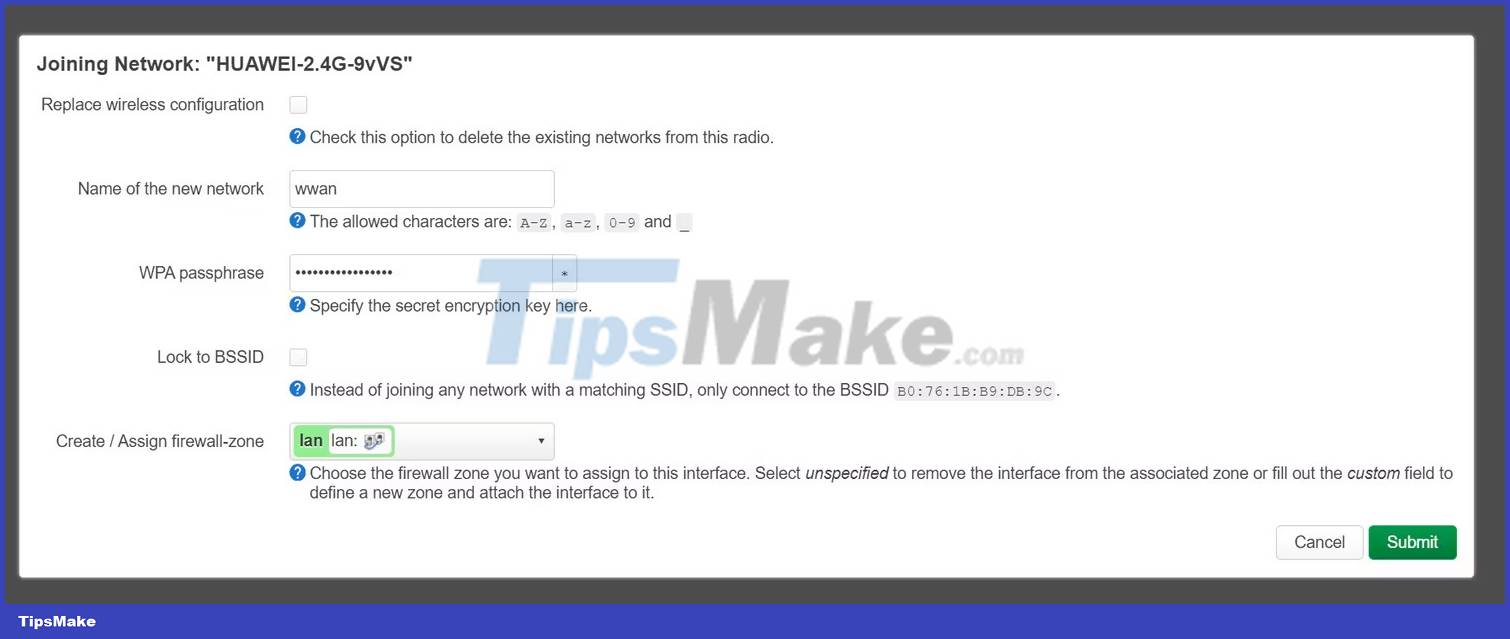
3. When you click Submit, the Device Configuration menu will appear. Set Operating Frequency to the same frequency as the main router's WiFi access point.
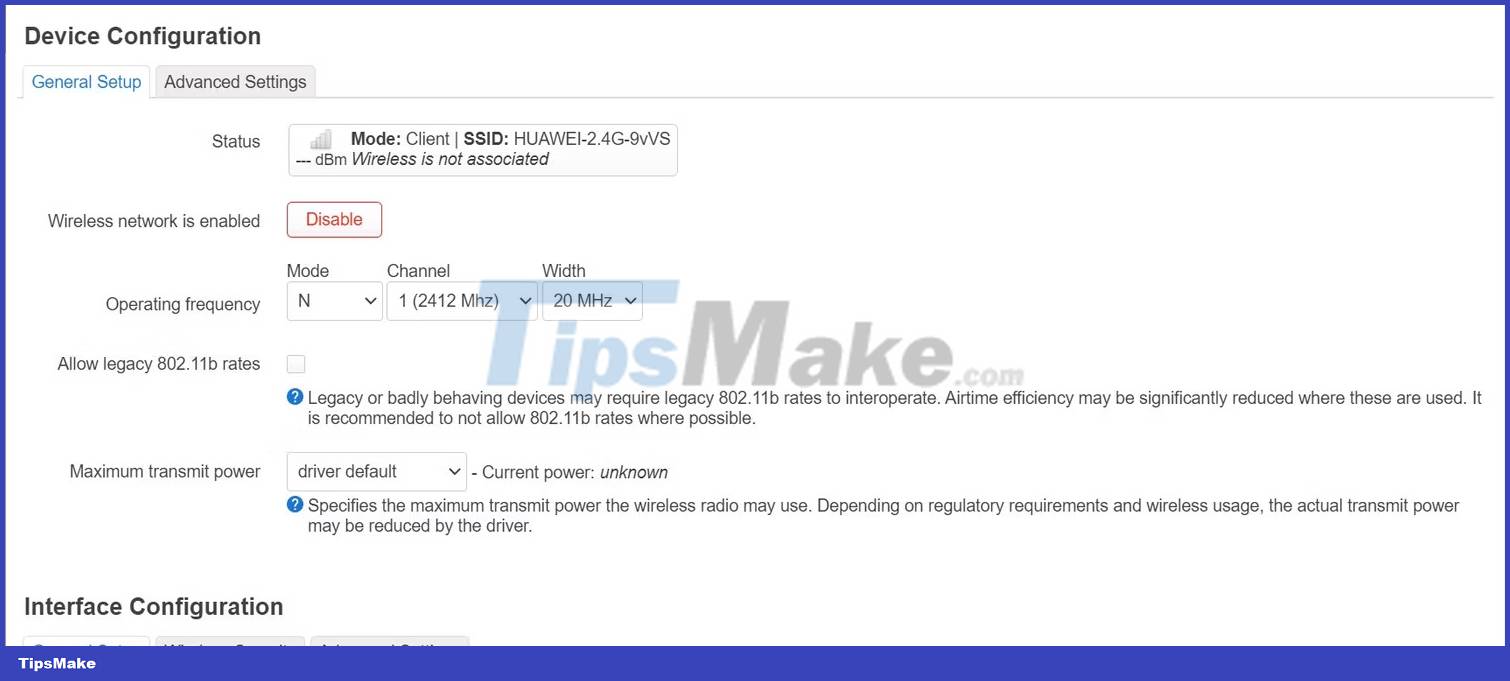
If you are not sure about the device's operating frequency, you can select Auto and leave everything as default before pressing Save.
Step 4: Connect the WiFi interface and LAN interface
The WiFi and LAN interfaces have been established, now we can connect them together to form a wireless bridge.
1. To set up a wireless bridge, navigate to Network > Interface and click Add new interface.
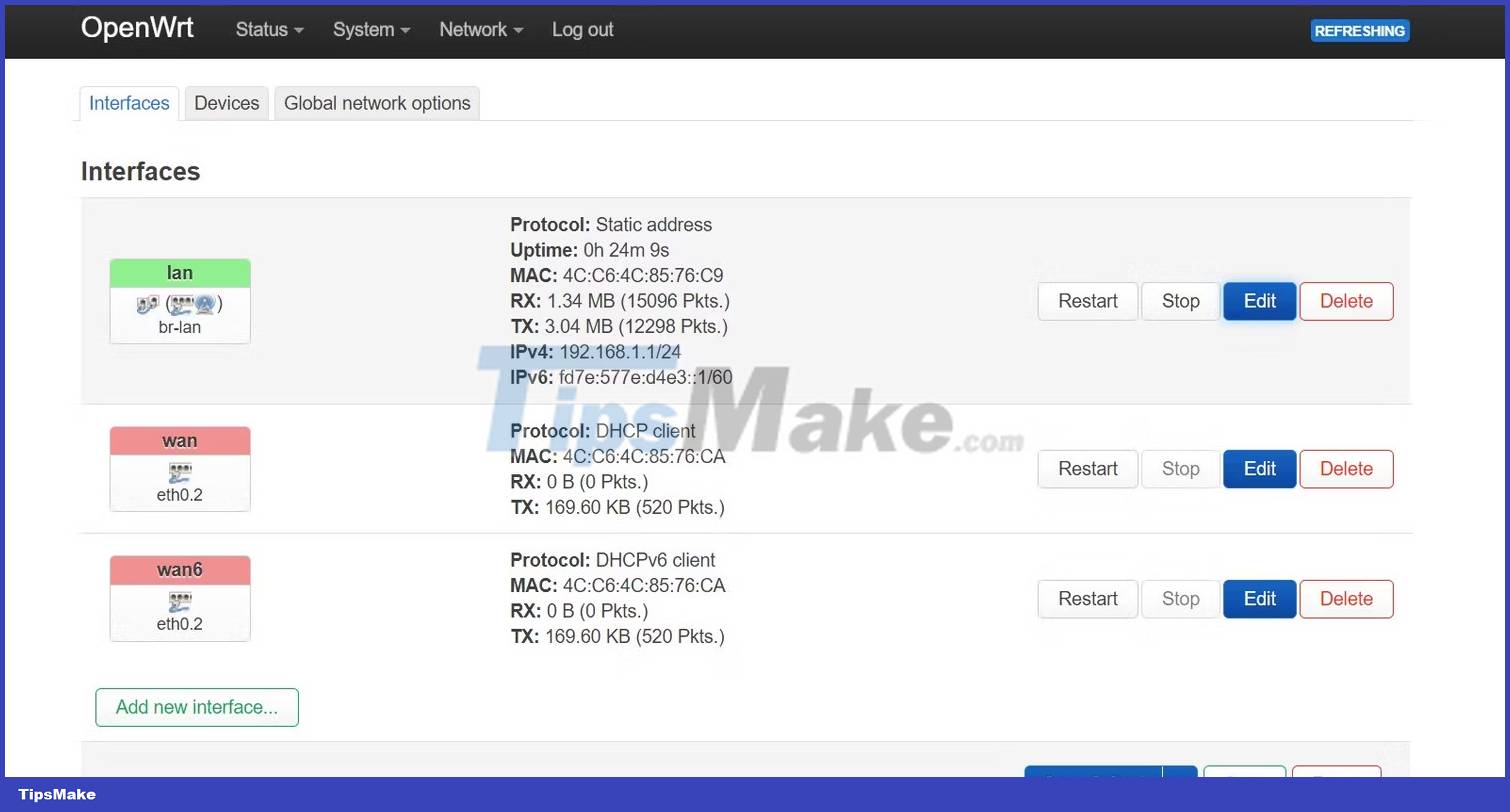
2. Now, give the wireless bridge a name and select Relay bridge as the protocol and click Create interface. If you cannot find the Relay bridge protocol, check to see if you have installed the luci-proto-relay software and make sure to reboot the old router.
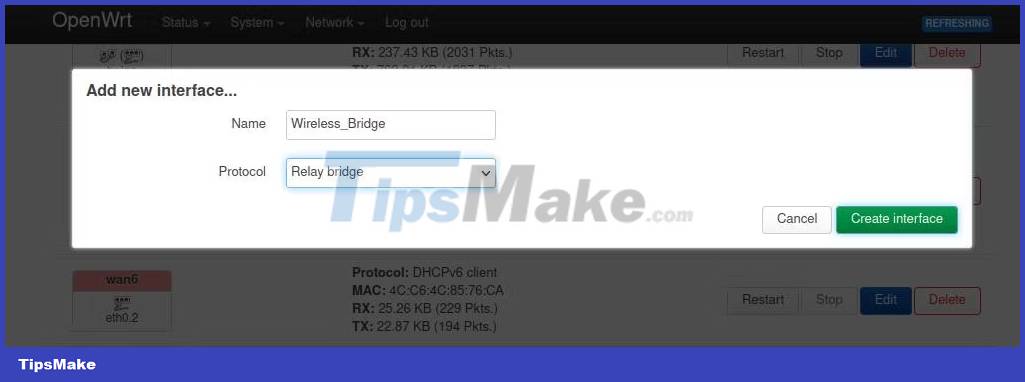
3. A general settings menu will appear when you create an interface. To connect both interfaces, you need to select both lan and wwan in the Relay between networks settings, then click Save.
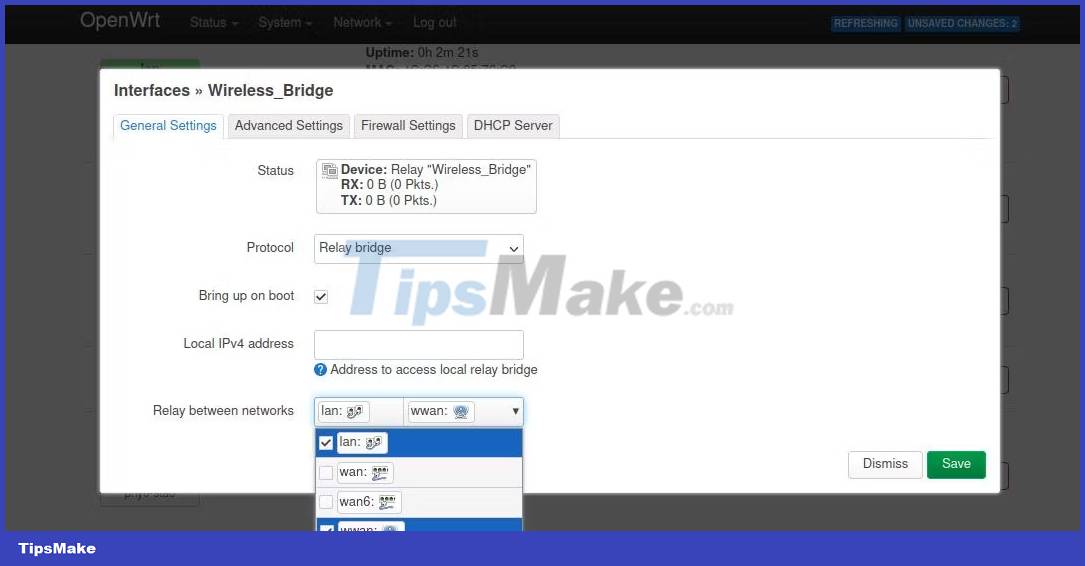
4. Now, make sure that both networks are specified in the same firewall zone. Select the Firewall Settings section on the toolbar and select lan and wwan in Assign firewall-zone, then click Save.
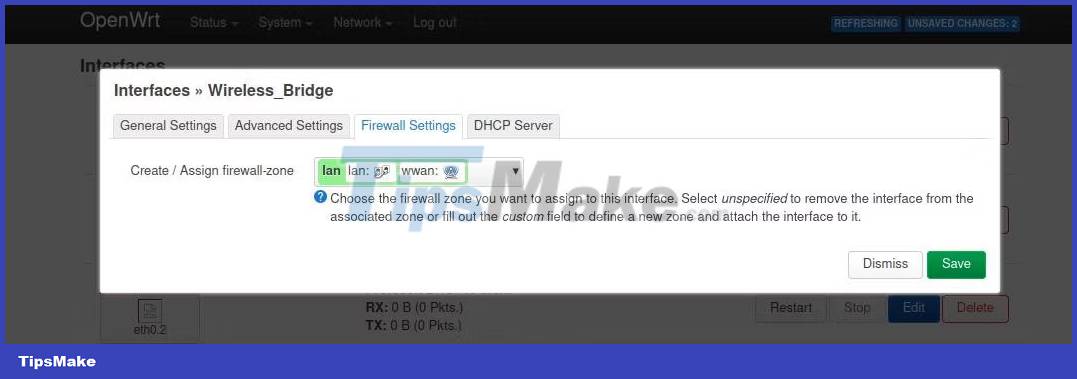
5. Now, click Save & Apply. Once the settings have been applied, you will be disconnected from OpenWrt's Luci web interface. This is normal. Because your old router is now a wireless bridge using the main router's default gateway, you can no longer access the old router's web configuration page.
Now, you can unplug the Ethernet cable connecting the main router and the old router because they are already connected wirelessly.
Congratulations! You now have a wireless bridge.
You should read it
- Guide to building an Ultimate Wireless Network
- How to secure the D-Link wireless router
- How to Make a Regular Printer Wireless with a Wi Fi Router
- How to Set Up a Wireless Router
- How to turn on the router's built-in firewall
- How to turn a Raspberry Pi into a WiFi Bridge
- Which type of wireless router has the longest range?
- 'Great' to speed up Wifi to Wireless Router
May be interested
- How to set a password for Wireless
 setting a password for a wireless device cpnf is called config wireless router. if you buy a good router, there will be documentation and manuals included. from there, you can set the encryption mode, security at your disposal. if in case you don't
setting a password for a wireless device cpnf is called config wireless router. if you buy a good router, there will be documentation and manuals included. from there, you can set the encryption mode, security at your disposal. if in case you don't - How to turn a laptop into a wireless repeater
 the connectify hotspot wireless repeater software makes your windows computer a wifi repeater easily and is also an important bridge, helping to avoid any incompatibility problems and problems.
the connectify hotspot wireless repeater software makes your windows computer a wifi repeater easily and is also an important bridge, helping to avoid any incompatibility problems and problems. - Why need to change the wireless channel of the router?
 the 2.4 and 5ghz wi-fi signal range is divided into a number of smaller strips called wireless channels. each wireless channel translates to a specific radio frequency
the 2.4 and 5ghz wi-fi signal range is divided into a number of smaller strips called wireless channels. each wireless channel translates to a specific radio frequency - How to configure Gpon IGATE GW040 G modem to Bridge mode
 the router's bridge mode mode is a bridge mode, replacing optical devices, intermediate parts and is under the control of another device and it is a secondary component in the network.
the router's bridge mode mode is a bridge mode, replacing optical devices, intermediate parts and is under the control of another device and it is a secondary component in the network. - How to set up WEP, WPA, WPA2 for Linksys router
 wireless connection is a necessity today and because of that, wireless security is essential to ensure safety in your local network.
wireless connection is a necessity today and because of that, wireless security is essential to ensure safety in your local network. - 5 tips to help make optimal use of Tomato on the Router
 in the following article, we will show you the 5 most useful tips for tomato, which help speed up your router and your work is done faster.
in the following article, we will show you the 5 most useful tips for tomato, which help speed up your router and your work is done faster. - Top 5 best Xiaomi WiFi routers
 wireless routers are being used in almost every corner of the world today. the best wireless router will ensure your network connections are strong and reliable.
wireless routers are being used in almost every corner of the world today. the best wireless router will ensure your network connections are strong and reliable. - 3 best wireless routers 2021
 whether you want the fastest and most powerful wifi router, feature set that focuses on gaming or wifi speeds just right and won't leave you out of pocket, there's always a wireless router option for you. it is important to know what to look for.
whether you want the fastest and most powerful wifi router, feature set that focuses on gaming or wifi speeds just right and won't leave you out of pocket, there's always a wireless router option for you. it is important to know what to look for. - Create a virtual wireless Router with Windows
 in this tutorial we will show you how to create a virtual wireless router in windows to share internet connection and file sharing.
in this tutorial we will show you how to create a virtual wireless router in windows to share internet connection and file sharing. - Review Tenda N301: The router is compact and affordable
 the tenda n301 router was released in 2013. tenda n301 is equipped with broadcom bcm5357c0 300 mhz chipset, 16mb ram and 2mb flash memory. tenda n301 wifi router is compatible with ieee 802.11b / g / n standards.
the tenda n301 router was released in 2013. tenda n301 is equipped with broadcom bcm5357c0 300 mhz chipset, 16mb ram and 2mb flash memory. tenda n301 wifi router is compatible with ieee 802.11b / g / n standards.










 6 best DNS servers to improve online safety
6 best DNS servers to improve online safety 5 reasons to upgrade to a Wi-Fi 7 router
5 reasons to upgrade to a Wi-Fi 7 router Microsoft begins testing Wi-Fi 7 on Windows 11
Microsoft begins testing Wi-Fi 7 on Windows 11 How to use Tester for Internet Speed PRO to check network speed
How to use Tester for Internet Speed PRO to check network speed Top 6 best WiFi routers, supporting WiFi 6
Top 6 best WiFi routers, supporting WiFi 6 Laptop disconnects from wifi when screen is turned off, effective solution
Laptop disconnects from wifi when screen is turned off, effective solution